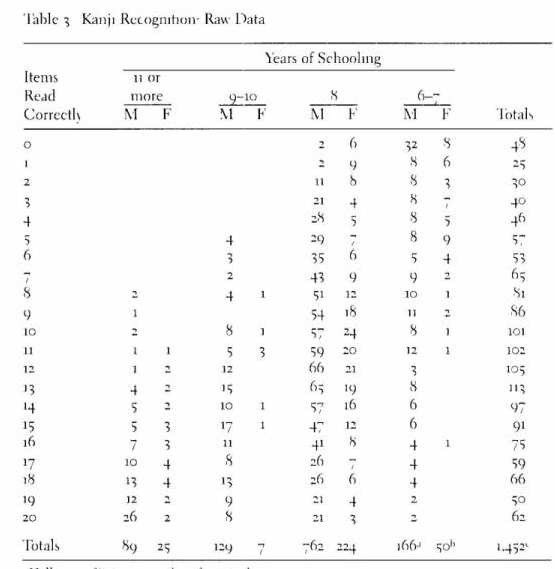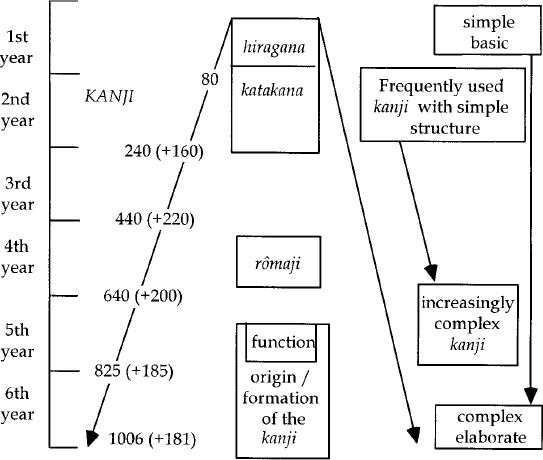December 25, 2006
Japanese literacy: back to the future again?
 Victor Mair sent in an article by Julian Ryall from the South China Morning Post of 12/16/2006, "Japanese forgetting how to write traditional characters", which begins:
Victor Mair sent in an article by Julian Ryall from the South China Morning Post of 12/16/2006, "Japanese forgetting how to write traditional characters", which begins:
So many Japanese are forgetting how to write kanji characters that cultural experts believe the country may eventually scrap the use of Chinese pictograms in favour of the 46 simplified hiragana characters.
Software maker Kanken DS has released a title that enables people to test their knowledge of characters - but was surprised to find that 90 per cent of the 400 people aged between 35 and 40 who took part in a study were unable to recall all the correct number and positioning of strokes for the 1,945 characters that are taught in public schools.
(A version also ran in The Scotsman under the headline "Keyboard may end traditional Japanese way of writing".) Victor's comment:
It's bound to happen, both with KANJI (Japanese) and with HANZI (Chinese), as it already essentially has with HANJA (Korean). The rapidity of character attrition is going to intensify within the next 5-10 years, so swiftly that people -- depending on their outlook -- will be astonished, dismayed, or overjoyed.
Ryall's article attributes the problem to use of cell phone texting and computer keyboards -- but at least in the case of Japan, I wonder if things are really very different now from how they were in a mythical golden age of Japanese kanji-literacy.
According to J. Marshall Unger, Literacy and Script Reform in Occupation Japan, 1996, p. 34:
The first full-fledged nationwide attempt to measure literacy in Japan was the survey conducted in 1948 under the auspices of the Civil Information and Education Section ... [which] involved the testing of about 17,000 Japanese men and women between the ages of 15 and 64 throughout the country. According to Ishiguro Yoshimi, who chaired the survey's Central Planning and Analysis Committee, the survey was of unprecendented scope and rigor not only by Japanese standards but by world standards as well. Although the survey is sometimes cited as proof that the level of literacy of the majority of prewar Japanese was high, it clearly shows that earlier government claims were grossly inflated. It was found that the rate of illiteracy (monmōritsu 'complete inability to read or write') was indeed very low, but it was also concluded that only 6.2 percent of the population were literate in terms of the survey definition, which was liberal.... By today's standards, all the questions were very simple. The ability to write kanji from dictation (kanji no kakitori), which was identified as the single most important skill tested, was found to be "remarkably low" in ALL groups surveyed. Performance was closely correlated with levels of formal education... Finally, the claim that the average Japanese experienced trouble dealing with the media of mass communication, a claim long made by script reform advocates, was deemed proven.
Neustupný points out that a second, smaller survey conducted in 1955-6 by the Ministry of Education produced similar results.
The survey covered subjects aged 14 to 26 in two selected areas, Tokyo and Northern Japan. The percentage of total illiterates in the survey was less than 1% in each of the two areas. On the other hand, those who were considered to "possess no competence in the use of the written language" and were expected to experience serious problems, made up approximately 10% of the Tokyo sample and 15% of the North-East Japan sample. However, another 50% or 60%, respectively, were also judged to lack sufficient competence, and some of these subjects definitely could be classified as functional illiterates (1984, 199)
Unger also cites data from a survey "conducted between December 1945 and January 1946 by the Kanamojikai, which tested 1,452 male and female workers in fourteen factories in and around Tokyo" using "stimulus materials ... that had been published ... in the Japanese press betwen 7 and 20 December 1945. Subjects were asked to give the readings for 20 comparatively uncommon kanji and kanji compounds and to explain the meaning of two sentences in the text, one considered easier than the other." He gives this summary of the results:

The results of the 1945-6 and 1948 surveys doubtless were affected by the war's interruption of education -- but the 1955-6 survey did not show a very different picture. I haven't been able to find any reference to comparable surveys done since 1955-6. It seems hard to believe that no such surveys exist -- if you know of any, please tell me -- but the situation should perhaps be interpreted in the light of this comment by Unger:
That the conservative elements in the LDP who were concerned with these issues worked so hard from 1959 to 1986 to achieve a reversal of perceptions is perhaps the highest compliment that the rōmaji and kanagaki enthusiasts of the 1940s and 1950s were ever paid.
An interesting perspective on the future of the Japanese writing system some from Christian Galan, "Learning to read and write in Japanese (kokugo and nihongo): a barrier to multilingualism?", International journal of the sociology of language, Issue 175-176, 2005. He begins with the premise that
Today, it has been fairly well established that assertions that there are no problems with teaching reading in Japanese schools, or evaluations of the literacy rate of the Japanese population at near 100%, are as much founded on ‘‘myth’’ as the supposed linguistic (or ‘‘racial’’) unity of Japan. In Japan, like anywhere else, there are problems with teaching reading in the schools, and there are various levels of literacy within Japanese society.
He provides a sort of flow-chart of Japanese reading instruction:

While kanji learning is a major part of Japanese children's education, most of it does not take place in the classroom:
...[T]he bulk of the work involved in learning the kanji (and thus learning to read) is relegated from fourth grade on, or even third grade in some schools, to work the children do on their own (Galan 2001: 31–37). The kanji, which up to that point were studied one by one during language classes, now become something the children study almost entirely ‘‘outside school’’. Although one hour a week is still devoted to the kanji, from this point on, school is really only the place where the results of the learning process are verified. ... (The parents, and especially the juku, play an extremely important role at this stage in the learning process).
Even before coming to (pre-)school, many if not most Japanese children have been taught hiragana by their mothers, and of course children of Japanese mothers will already know the language well. Galan juxtaposes the Japanese system of reading instruction with another dimension of Japanese life:
The Japanese statistics bureau’s projections, based on current birth rate figures, estimate the population of Japan in one century (2100) at just over half (±67,000,000) the population of today (±127,000,000). Whatever general solution the Japanese authorities decide on to resolve the impending shortage of workers (projections show 1 retired person for every 1.5 workers in 2050) (Sōmushō 2000), it is hard to see how they could avoid resorting to foreign immigration on some scale. This is a topic of great debate in Japan, and should the country ever implement an active immigration policy, it would certainly be highly controlled and regulated.
However, as Galan already pointed out,
The Japanese school system is currently set up to ‘‘teach reading’’ to Japanese children who are born of Japanese parents and raised in Japan, who speak Japanese from birth and live in an environment in which the only language spoken, heard and written is Japanese.
Despite this, the system has apparently never done a very good job of teaching the requisite list of kanji to the population as a whole. At least, it didn't succeed very well in the 30s, 40s and 50s, according to the surveys, and if the Kanken results are to be trusted, it's not succeeding very well now. It's hard to imagine a system of immigration, however controlled, that could overcome the educational problems created by insisting on the continued large-scale use of kanji.
In fact, there is a confluence here of practical educational problems with the more general problems of group identify that make the issue of immigration so contentious. Galan quotes Unger 1987 in support of an obvious generalization: ‘‘The Japanese attachment to kanji is intimately tied to the shared experience of mastering a complex body of knowledge that defines group membership.’’
Linguistic pluralism, assimilation, integration through language, internationalization . . . no matter how the linguistic situation in Japan evolves in the future, or how the country’s leaders try to make it evolve, these leaders will not, in our opinion, be able to avoid reassessing the issue of their writing system. We fully agree with Unger’s statement that ‘‘Japanese society may have turned its back on script reform for the time being, but the underlying issues have not gone away.’’
Perhaps it will be possible to finesse the script-reform aspects of this problem by allowing the baneful influence of cell-phone texting and other modern innovations to accomplish changes de facto, without ever agreeing that the current writing system is in any essential need of reform. Then the cultural problems of immigration and its impact on nihonjinron can be engaged without further loss of face.
[Experienced Language Log readers should immediately wonder whether Julian Ryall's description of the alleged results of an (unsourced) study, associated somehow with a company's efforts to sell video games that test the knowledge whose deficiency the study allegedly uncovered, might be misleading or even completely fabricated. We have no special reason to mistrust Mr. Ryall, though his use of the term "pictrograms", and his misconstrual of the name of the game "KanKen DS" for the name of the company selling it ("Rocket"), suggest a certain lack of background for writing about this topic. However, it's a good general rule never to believe what you read (at least about scientific topics construed broadly) in the traditional media, which lack any mechanism to enforce the elementary standards of accuracy and accountability that we take for granted in the blogosphere.
For example, it's possible that the study simply showed that 90% of subjects (from what sample?) missed at least one character in a test of (what subset of?) the 1,945 jōyō kanji. Depending on how such an experiment was conducted, it might not mean much. And then again, maybe there was no actual experiment at all, but just someone's guess about how such an experiment would probably come out if someone were to do it. We've seen plenty of stories of both kinds widely and prominently printed in the world's papers... see here, here, here for a few examples. Then again, the study that Ryall cited (or rather, alluded to) might well support the conclusions implicit in his article. As a result of the almost complete lack of journalistic standards with respect to such things, we just can't tell.
If you know anything more about this game, the "study" alluded to, or the current state of kanji knowledge among the Japanese, please let me know.]
[Update -- Matt at No-Sword has found the Rocket Co. press release, and confirms my suspicions:
What seems to be Rocket Company's press release about the survey does not mention any actual testing. The questions are more along the lines of "Do you think your kanji skills have weakened in the past few years?" and "Do you have less occasion to write kanji than you used to?" and "Do you think that the kids today, they don't learn kanji properly, the way you did when you were their age? If yes, do you also find that they should get off your lawn and/or put a sock in that damn rocks-and-rolls 'music', if you can even call it that?" (I may have embellished that last one.) [...]
So, let's not give this survey more credence than it deserves, which is, "As much as any other opinion poll conducted on behalf of organizations with directly related products and services to sell."
Matt concludes:
Of course, it makes perfect sense that as the need to actually write kanji diminishes, people's ability to write them will go down too. But down to zero? Within five years to a decade? That's either doom-saying, wishful thinking, or straight-up non-sense. Sure, they'll probably continue to get gradually rarer in written documents (you know -- priceless cultural artifacts like shopping lists and post-it notes on computer screens saying "12:30 Tanaka-san called")... but why would people stop using them in electronic documents when the UI itself is a willing scribe?
If you combine handwriting and electronic entry, people's ability to produce kanji one way or another is probably going through the roof -- and isn't that exactly the kind of thing humans invented computers for in the first place?
In this case, I think I'm inclined to agree with Matt more than with Victor. But if the projections about population decline are valid, then the questions about how to make the writing system work in the context of significant immigration may be genuine and serious. ]
Posted by Mark Liberman at December 25, 2006 12:51 PM